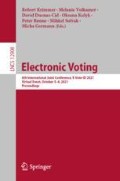Abstract
Accurately determining the outcome of an election is a complex task with many potential sources of error, ranging from software glitches in voting machines to procedural lapses to outright fraud. Risk-limiting audits (RLA) are statistically principled “incremental” hand counts that provide statistical assurance that reported outcomes accurately reflect the validly cast votes. We present a suite of tools for conducting RLAs using confidence sequences—sequences of confidence sets which uniformly capture an electoral parameter of interest from the start of an audit to the point of an exhaustive recount with high probability. Adopting the SHANGRLA [13] framework, we design nonnegative martingales which yield computationally and statistically efficient confidence sequences and RLAs for a wide variety of election types.
Access this chapter
Tax calculation will be finalised at checkout
Purchases are for personal use only
Notes
- 1.
Code to reproduce all plots can be found at github.com/wannabesmith/RiLACS.
- 2.
At any point during the sampling, an election official can choose to abort the sampling and perform a full hand count for any reason. This cannot increase the risk limit: the chance of failing to correct an incorrect reported outcome does not increase.
- 3.
Notice that it is not always feasible to compute the set of all \(\mu \in [0, 1]\) such that \(\phi _t^\mu = 0\) since [0, 1] is uncountably infinite. However, all confidence sequences we will derive in this section are intervals (i.e. convex), and thus we can find the endpoints using a simple grid search or standard root-finding algorithms.
- 4.
- 5.
The use of the word “prior” here should not be interpreted in a Bayesian sense. No matter what values of \((\theta _1, \dots , \theta _D)\) are chosen, the resulting tests and confidence sequences have frequentist risk-limiting guarantees.
References
Blom, M., et al.: Assertion-based approaches to auditing complex elections, with application to party-list proportional elections. In: Krimmer, R., et al. (eds.) E-Vote-ID 2021, LNCS 12900, pp. 47–62. Springer, Cham (2021)
Howard, S.R., Ramdas, A., McAuliffe, J., Sekhon, J.: Time-uniform Chernoff bounds via nonnegative supermartingales. Probab. Surv. 17, 257–317 (2020)
Huang, Z., Rivest, R.L., Stark, P.B., Teague, V.J., Vukcevic, D.: A unified evaluation of two-candidate ballot-polling election auditing methods. In: Krimmer, R., et al. (eds.) E-Vote-ID 2020. LNCS, vol. 12455, pp. 112–128. Springer, Cham (2020). https://doi.org/10.1007/978-3-030-60347-2_8
Jamroga, W., Roenne, P.B., Ryan, P.Y.A., Stark, P.B.: Risk-limiting tallies. In: Krimmer, R., et al. (eds.) E-Vote-ID 2019. LNCS, vol. 11759, pp. 183–199. Springer, Cham (2019). https://doi.org/10.1007/978-3-030-30625-0_12
Kelly, J., Jr.: A new interpretation of information rate. Bell Syst. Tech. J. 35(4), 917–926 (1956)
Lindeman, M., Stark, P.B., Yates, V.S.: BRAVO: ballot-polling risk-limiting audits to verify outcomes. In: 2012 Electronic Voting Technology Workshop/Workshop on Trustworthy Elections (EVT/WOTE 2012). USENIX Association, Bellevue, August 2012. https://www.usenix.org/conference/evtwote12/workshop-program/presentation/lindeman
Ottoboni, K., Bernhard, M., Halderman, J.A., Rivest, R.L., Stark, P.B.: Bernoulli ballot polling: a manifest improvement for risk-limiting audits. In: Bracciali, A., Clark, J., Pintore, F., Rønne, P.B., Sala, M. (eds.) FC 2019. LNCS, vol. 11599, pp. 226–241. Springer, Cham (2020). https://doi.org/10.1007/978-3-030-43725-1_16
Ottoboni, K., Stark, P.B., Lindeman, M., McBurnett, N.: Risk-limiting audits by stratified union-intersection tests of elections (SUITE). In: Krimmer, R., et al. (eds.) E-Vote-ID 2018. LNCS, vol. 11143, pp. 174–188. Springer, Cham (2018). https://doi.org/10.1007/978-3-030-00419-4_12
Rivest, R.L.: ClipAudit: a simple risk-limiting post-election audit. arXiv preprint arXiv:1701.08312 (2017)
Stark, P.B.: Conservative statistical post-election audits. Ann. Appl. Stat. 2(2), 550–581 (2008)
Stark, P.B.: CAST: canvass audits by sampling and testing. IEEE Trans. Inf. Forensics Secur. 4(4), 708–717 (2009)
Stark, P.B.: Risk-limiting postelection audits: conservative \(p\)-values from common probability inequalities. IEEE Trans. Inf. Forensics Secur. 4(4), 1005–1014 (2009)
Stark, P.B.: Sets of half-average nulls generate risk-limiting audits: SHANGRLA. In: Bernhard, M., et al. (eds.) FC 2020. LNCS, vol. 12063, pp. 319–336. Springer, Cham (2020). https://doi.org/10.1007/978-3-030-54455-3_23
Ville, J.: Etude critique de la notion de collectif. Bull. Amer. Math. Soc. 45(11), 824 (1939)
Waudby-Smith, I., Ramdas, A.: Estimating means of bounded random variables by betting. arXiv preprint arXiv:2010.09686 (2021)
Author information
Authors and Affiliations
Corresponding author
Editor information
Editors and Affiliations
Rights and permissions
Copyright information
© 2021 Springer Nature Switzerland AG
About this paper
Cite this paper
Waudby-Smith, I., Stark, P.B., Ramdas, A. (2021). RiLACS: Risk Limiting Audits via Confidence Sequences. In: Krimmer, R., et al. Electronic Voting. E-Vote-ID 2021. Lecture Notes in Computer Science(), vol 12900. Springer, Cham. https://doi.org/10.1007/978-3-030-86942-7_9
Download citation
DOI: https://doi.org/10.1007/978-3-030-86942-7_9
Published:
Publisher Name: Springer, Cham
Print ISBN: 978-3-030-86941-0
Online ISBN: 978-3-030-86942-7
eBook Packages: Computer ScienceComputer Science (R0)

